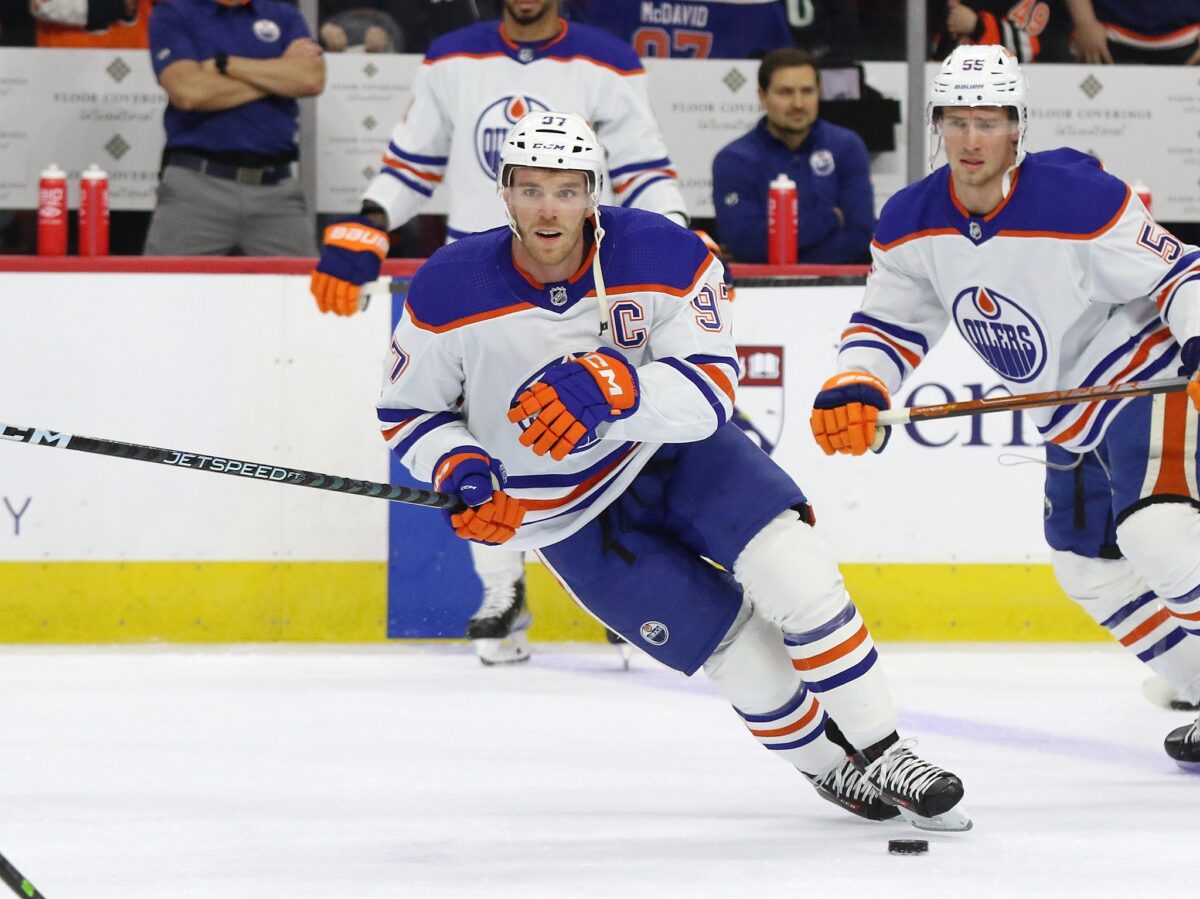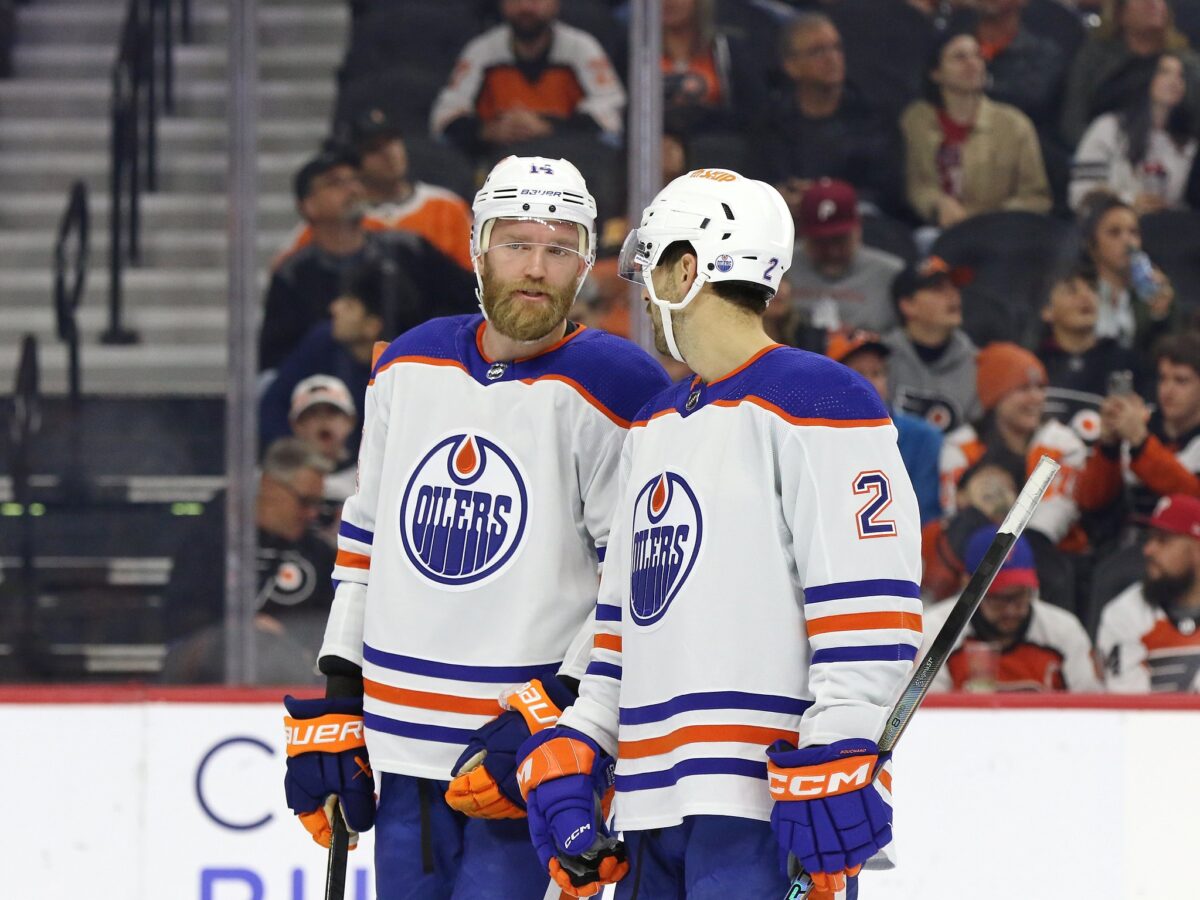Many pundits predicted the Edmonton Oilers as Pacific Division winners and potential Stanley Cup contenders in the Western Conference for the 2023-24 season. I wrote myself that they’d be one of four possible contenders in the West, along with the Dallas Stars, Vegas Golden Knights and Colorado Avalanche.
The latter three have lived up to the potential Stanley Cup contender label, but that hasn’t been the case for the Oilers. After their 3-0 loss to the New York Rangers, they fell to 1-5-1 on the season, and their hopes of catching the Golden Knights for the division are already getting slim.
Is there cause for concern in Edmonton? Absolutely, but it’s not time to panic yet. The Oilers are doing some things well, specifically at five-on-five, and there could be better luck in the near future.
Oilers Offense Getting Unlucky
It’s hard to sell that a team is playing well at five-on-five when their record is 1-5-1, but the Oilers’ metrics at that game state are among the top half of the league and even rank in the top 10 in some categories, partially due to their offense.
Through ten games, the Oilers have an expected goals share (xG%) of 54.58 percent, ranked eighth in the league, just behind the Calgary Flames, who are also struggling to get wins.
Related: Early Oilers Overreactions Turn to Harsh Reality
As expected, the Oilers have been able to create chances at five-on-five. They’re averaging 3.11 expected goals per 60 minutes, ranked first in the NHL, just ahead of the Los Angeles Kings. They’re also averaging the most high-danger chances per 60 minutes in the league.
The Oilers have just 17 goals on the season, but their number suggests they should be scoring more, even much more. Connor McDavid’s injury doesn’t help, but it isn’t long-term, and he could be back in action at the Heritage Classic on Oct. 29 or soon afterward.
Latest THW Headlines
McDavid is the best player in the world, so getting him back obviously helps. But even before then, the Oilers could start finding the back of the net more often. As a team, they’re shooting just 6.1 percent at five-on-five, the sixth-lowest rate in the league.

The Oilers shot 9.14 percent at five-on-five a season ago, and with the talent they have, they can easily get back to that level, especially with the amount of quality chances they’re creating. For example, there are a few individuals who are performing below their expected numbers.
Zach Hyman’s two goals are a bit below the 3.02 expected goals he’s generated at five-on-five. Evander Kane has zero goals on 1.16 xG, Mattias Janmark hasn’t scored on 1.42 xG, and Connor Brown — the Oilers’ main offseason addition — has no tallies on 1.08 expected goals.
If these players keep generating the quality chances they have, they will find the back of the net sooner than later. I don’t have many concerns with the Oilers’ offense. They’re due for better luck, especially once McDavid returns. It’s the other parts of their game that are more a cause for concern.
Oilers’ Transition to Zone Defense Hasn’t Gone Smoothly
To say the Oilers’ defense was a question mark heading into the season might be a stretch, but at the same time, I don’t think anyone mistook this unit as the team’s strength. Their team defense hasn’t been awful; they’re giving up 2.55 expected goals per 60 minutes. But there are issues to sort out.
For example, take the team’s 7-4 loss to the Minnesota Wild a few nights ago. The Oilers took a 3-2 lead into the third period before imploding defensively and giving up four non-empty net goals in the final frame. So, while the defensive numbers may look good, the Oilers have gone through stretches like that where their defense falls apart at the seams.
One reason for the defensive struggles may be that the Oilers have switched from man-to-man to zone defense. They’re not the only team to have done so. The Golden Knights and Tampa Bay Lightning run a zone-defense scheme, as do the Boston Bruins, which The Athletic highlighted in a recent article (From “NHL copycats: Why are teams ditching man-to-man for zone defense?” – The Athletic, 10/25/2023).
As Fluto Shinzawa and Julian McKenzie stated in their article for The Athletic, man-to-man defense is becoming increasingly less aligned with the NHL, given how fast and skilled players are in 2023. That’s why some teams have switched to zone and why they’re having success.

I grew up playing basketball, but zone defense in hockey seems to have similar principles. Each player has an area of the ice they have to cover. In basketball, if you’re a guard, you’re likely playing up top and protecting the perimeter around the three-point line in a 2-3 zone. If you’re a center or power forward, guarding the paint and post-ups becomes your assignment in a 2-3 zone.
Or think of a cover-2 defense in football. Cornerbacks will have a zone to cover (as do the linebackers). But if executed properly, they’ll have help over the top coming from either the strong or free safety.
Wingers will have their place in a zone defense in hockey, as will centers and defensemen. For the Oilers, this is an entirely new system, so an adjustment period should be expected for them. And when looking at the Oilers’ goaltending numbers, it’s fair to wonder if the switch to zone defense has affected Jack Campbell and, specifically, Stuart Skinner.
Skinner was one of the better goaltenders in the NHL a season ago, totaling a .913 save percentage in 50 games and receiving votes for the Calder Trophy. But he’s off to an abysmal start this season, with an .843 SV% in four games and three starts.
The good news is that he’s due for positive regression from an .843 save percentage, but it’s also possible he’s getting used to the new defensive system and the players’ tendencies in front of him. It’s like when a goalie signs or gets traded to a new team. Sometimes, it takes a little while to get comfortable with what’s in front of you.
In that sense, Skinner is also due for better luck. But it really depends on how long it takes the team in front of him to get used to zone defense. Their 3-0 loss to the Rangers suggests they aren’t there yet, and that’s a problem not only for Skinner but for the team.
Oilers Have Time to Turn It Around, But It Has to Happen Soon
Something will have to give in the Heritage Class against the Flames — a tilt that almost seems like a must-win for the Oilers. They’ll play the Stars in their ensuing contest, but their schedule should become a bit more favorable after that. Their following five games are against the Nashville Predators, Vancouver Canucks, the lowly San Jose Sharks, the Seattle Kraken and New York Islanders.
It’s not panic time in Edmonton just yet. The Oilers are due for better luck offensively, specifically at five-on-five, and that stretch of games may help them break out. But turning around their season will ultimately come down to how fast they adjust to zone defense and getting Skinner on the right track. If that doesn’t happen soon, it could result in one of the most disappointing seasons we’ve seen relative to preseason expectations in quite some time.
* * *
Advanced stats from Natural Stat Trick
